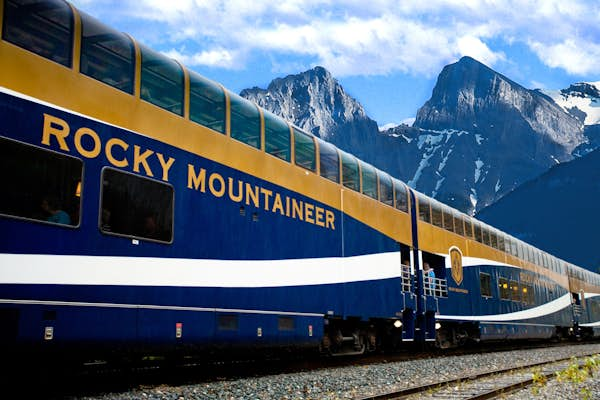The Rocky Mountaineer passenger train has three main rail routes through Western Canada and two different service levels from which to choose, each with their own stunning views of the Canadian Rockies and luxury amenities. All options either start or end in Vancouver, and there are plenty of ways to customize, but here’s what you need to know if you’re trying to decide.

Rail Routes
First Passage to the West
• Main stops: Vancouver, Kamloops, Banff/Lake Louise
• Days on board: 2
• Highlights: Spiral Tunnels, Continental Divide, the Last Spike at Craigellachie, Hell’s Gate
• Easy excursions near Banff/Lake Louise: Moraine Lake, Whyte Museum of the Canadian Rockies, Cave & Basin National Historic Site, Upper hot springs pool, Fairmont Banff Springs, Banff Gondola
• Price: From $1,287 USD (Includes accommodations in Kamloops)
Journey Through the Clouds
• Main stops: Vancouver, Kamloops, Jasper
• Days on board: 2
• Highlights: Mount Robson, Pyramid Falls, Hell’s Gate
• Easy excursions near Jasper: Icefields Parkway, Athabasca Glacier, Miette hot springs, Maligne Lake, Jasper Skytram
• Price: From $1,287 USD (Includes accommodations in Kamloops)
Rainforest to Gold Rush
• Main stops: Vancouver, Whistler, Quesnel, Jasper
• Days on board: 3
• Highlights: Whistler, Fraser River Bridge
• Easy excursions: Audain Art Museum, Peak 2 Peak Gondola, Whistler Museum & Archives,
Squamish Lil’wat Cultural Centre
• Price: From $1,761 USD (Includes accommodations in Whistler and Quesnel)

Service Levels
There are two different service levels, called SilverLeaf and GoldLeaf, with GoldLeaf upward of $475 USD extra. Here’s how the service levels differ.
Train car
• GoldLeaf: The two-level carriage features a glass domed roof for unobstructed views all the way up. There is also a small outdoor standing platform where you can feel the wind in your hair and get some photos without the windows distorting the view.
• SilverLeaf: A single-level carriage with windows that are very large but don’t quite go all the way to the ceiling. Still, quite a big upgrade from the large windows in, say, a chartered bus.
Dining
• GoldLeaf: The lower level of a GoldLeaf-level car is a private dining room and kitchen, where half the carriage at a time will be seated for two gourmet meals each day on the rails. These meals are really a step above, with specialty options and local ingredients.
• SilverLeaf: Passengers get a more limited, but still delicious, menu and meals are served in your seat instead of a dedicated dining room.
Accommodations
• GoldLeaf: Mid-trip accommodations tend to be in the 4- or 5-star range.
• SilverLeaf: You’ll more likely be staying in 3-star level accommodations.
Available on both service levels
Complimentary alcoholic and non-alcoholic beverages are available on both service levels, along with engaging (and often hilarious) stories from attentive hosts. You’ll also be treated to hot towels, snacks, a delicious cinnamon bun, and a toast to a great journey.
How to choose
If you have the funds, we can’t recommend the GoldLeaf service highly enough. But if you’d rather save a little bit of dough you can opt for the SilverLeaf with few reservations. Both experiences are luxury-level. Although the upgraded meals and dedicated dining room on the GoldLeaf service are great, the meals on the SilverLeaf level are delicious as well. And after a long day on the rails, the 3-star accommodations are plenty good enough (It’s really just a place to catch some shut-eye, anyway). Believe it or not, the thing we’d miss most on the SilverLeaf level would be the small outdoor riding platform.
Lonely Planet writer Ben Buckner travelled to western Canada with assistance from Rocky Mountaineer. Lonely Planet contributors do not accept freebies in exchange for positive coverage.
